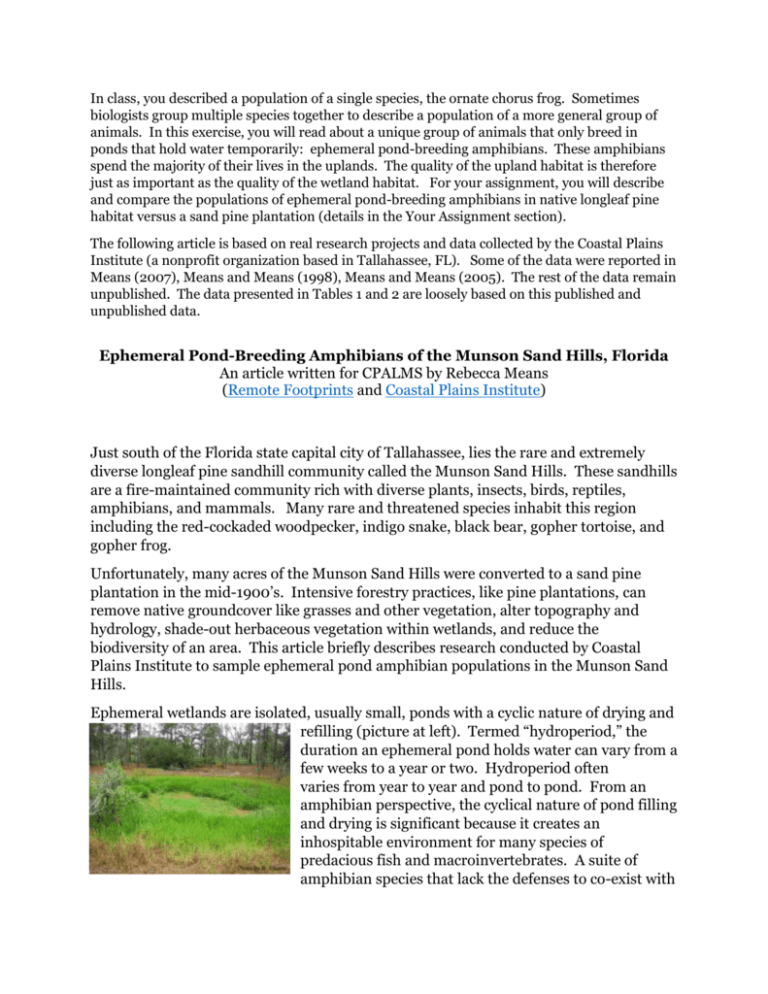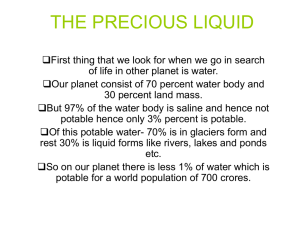Describe a Population Worksheet
advertisement

In class, you described a population of a single species, the ornate chorus frog. Sometimes biologists group multiple species together to describe a population of a more general group of animals. In this exercise, you will read about a unique group of animals that only breed in ponds that hold water temporarily: ephemeral pond-breeding amphibians. These amphibians spend the majority of their lives in the uplands. The quality of the upland habitat is therefore just as important as the quality of the wetland habitat. For your assignment, you will describe and compare the populations of ephemeral pond-breeding amphibians in native longleaf pine habitat versus a sand pine plantation (details in the Your Assignment section). The following article is based on real research projects and data collected by the Coastal Plains Institute (a nonprofit organization based in Tallahassee, FL). Some of the data were reported in Means (2007), Means and Means (1998), Means and Means (2005). The rest of the data remain unpublished. The data presented in Tables 1 and 2 are loosely based on this published and unpublished data. Ephemeral Pond-Breeding Amphibians of the Munson Sand Hills, Florida An article written for CPALMS by Rebecca Means (Remote Footprints and Coastal Plains Institute) Just south of the Florida state capital city of Tallahassee, lies the rare and extremely diverse longleaf pine sandhill community called the Munson Sand Hills. These sandhills are a fire-maintained community rich with diverse plants, insects, birds, reptiles, amphibians, and mammals. Many rare and threatened species inhabit this region including the red-cockaded woodpecker, indigo snake, black bear, gopher tortoise, and gopher frog. Unfortunately, many acres of the Munson Sand Hills were converted to a sand pine plantation in the mid-1900’s. Intensive forestry practices, like pine plantations, can remove native groundcover like grasses and other vegetation, alter topography and hydrology, shade-out herbaceous vegetation within wetlands, and reduce the biodiversity of an area. This article briefly describes research conducted by Coastal Plains Institute to sample ephemeral pond amphibian populations in the Munson Sand Hills. Ephemeral wetlands are isolated, usually small, ponds with a cyclic nature of drying and refilling (picture at left). Termed “hydroperiod,” the duration an ephemeral pond holds water can vary from a few weeks to a year or two. Hydroperiod often varies from year to year and pond to pond. From an amphibian perspective, the cyclical nature of pond filling and drying is significant because it creates an inhospitable environment for many species of predacious fish and macroinvertebrates. A suite of amphibian species that lack the defenses to co-exist with these predators require ephemeral ponds for breeding habitat. Therefore, ephemeral ponds support a different assemblage of species than do more permanent waters. In the Munson Sand Hills, ephemeral ponds are essential to the survival of two imperiled amphibians – the striped newt and the gopher frog (pictured below at right). Other amphibians also depend on these wetland including mole salamanders (pictured below at center), barking treefrogs (pictured below at left), pine woods treefrogs, little grass frogs, ornate chorus frogs, southern chorus frogs, and oak toads. Twice a year over a four year period, biologists with Coastal Plains Institute sampled 245 ponds in the Munson Sand Hills using seines and dipnets. Some of the ponds (65%) were located on the Apalachicola National Forest, an area with a native longleaf pine savanna community. The other ponds (35%), were surrounded by intensively managed sand pine plantation. Was there a difference in the ephemeral pond-breeding amphibian populations found in native longleaf pine savanna versus sand pine plantation? References Means, D. B. 2007. Life cycles, dispersal, and critical habitat utilization of vertebrates dependent upon small isolated water bodies in the Munson Sandhills and Woodville Karst Plain, Leon County, Florida. Final Report to the Department of Transportation for OMNI Project 010562. 69 pages. Means, D. B. and R. C. Means. 1998. Distribution of the striped newt (Notophthalmus perstriatus) and gopher frog (Rana capito) in the Munson Sand Hills of the Florida panhandle. Final report to the U. S. Fish and Wildlife Service, Jackson, MS, for Order No. 43910-5-0077. Means, D. B. and R. C. Means. 2005. Effects of sand pine silviculture on pond-breeding amphibians in the Woodville Karst Plain of north Florida. Pages 56-61 in W. Meshaka and K. Babbitt, eds. Status and conservation of Florida amphibians and reptiles. Florida University Presses, Gainesville, Florida. Your Assignment Fill out the tables on the next page to obtain information about ephemeral pondbreeding amphibian populations in two different habitats. Use the characteristics of a population you learned in class to compare the two different populations in the Munson Sand Hills. Write a two page paper that describes each population (longleaf pine savanna and sand pine plantation) then use the observations to make inferences about the population. You may choose to use the observations to make inferences about individual species, the ephemeral-pond breeding amphibian population as a whole, or both. Be sure to describe your inferences based on the observations and any factors that may strengthen or potentially invalidate your inferences. For example, did you infer anything from the fact that only adults were encountered for several species in the sand pine plantation habitat? Would knowing that the tadpoles of these species depend on herbaceous vegetation to hide from predators strengthen your inference? Be sure to attach your completed tables (Page 3 and 4) with your paper. Hint: Remember populations can be described at different scales. Our in-class example looked at population density in terms of # of individuals/pond area (m2). In this exercise you will need to calculate density in terms of number of individuals/pond or average number of individuals/pond. Table 1. An Example of Amphibian Population Data Collected During Surveys in the Munson Sand Hills – Longleaf Pine Savanna Habitat. A total of 160 ponds were sampled. Species Percentage of Ponds Detected Small Larvae (< mm) Eggs Large Larvae (> mm) Total Number of Individuals Adults Male Female Mole salamander 25% 0 953 501 800 754 Striped newt 18% 0 1,216 1,200 451 398 Barking treefrog 45% 28,754 2,555 3,450 620 632 Ornate chorus frog 42% 23,522 1,780 880 223 265 Southern chorus frog 53% 15,420 2,420 3,001 599 606 Gopher frog 26% 12,250 42 804 201 255 Averages Totals (eggs, larvae, and adults) Density (Average number of individuals per wetland) Table 2. An Example of Amphibian Population Data Collected During Surveys in the Munson Sand Hills – Sand Pine Plantation Habitat. A total of 85 ponds were sampled. Species Mole salamander Percentage of Ponds Detected Small Larvae (< mm) Eggs Adults Large Larvae (> mm) Male Female 13% 0 0 1 15 18 Striped newt 0% 0 0 0 0 0 Barking treefrog 2% 0 0 0 1 3 17% 0 0 20 8 8 Southern chorus frog 8% 0 0 0 20 23 Gopher frog 1% 0 0 0 0 1 Ornate chorus frog Averages Totals Total Number of Individuals (eggs, larvae, and adults) Density (Average number of individuals per wetland) Grading Rubric Describing a Two Populations of Ephemeral Pond-Breeding Amphibians Rubric Below Standard (1 Approaching Above Standard (4 At Standard (3 pts) pt) Standard (2 pts) pts) Learning Objective Frequent errors in Few errors in spelling or No errors in spelling or Many errors in spelling spelling and grammar grammar. Writing is grammar. Writing is or grammar. Writing is Mechanics of Writing distract the reader. cohesive and organized. very cohesive and well disorganized. Main Writing lacks strong Main points are organized. Main points points are not described. organization. described. are clearly described. Characteristics of a Population (includes number of individuals, age structure, density, distribution) Little or no description of population characteristics is included. Student fails to demonstrate an understanding of how to describe a population. Several population characteristics are missing or student describes only one thoroughly. Student demonstrates a minimal understanding of how to describe a population. A few population characteristics are included for each population. Student demonstrates a basic understanding of population structure. All population characteristics are included for both populations. Student demonstrates a thorough understanding population structure. Comparison No comparison between the two populations is included. No population characteristic vocabulary is used. Very little comparison is made between the two populations. Few population characteristics vocabulary words are used. Comparisons between the two populations are made and some population characteristic vocabulary words are used. Comparisons between the two populations are thoroughly described using appropriate new vocabulary words. Three inferences about the population are made and are described. Descriptions reflect a basic understanding of of observation and inference. More than three inferences about the populations are made and are described thoroughly. Descriptions reflect a complete and thorough understanding of the relationship between observation and inference. Observation/Inference No inferences about the two populations are made. One or two inferences about the population are made but are not described thoroughly.







